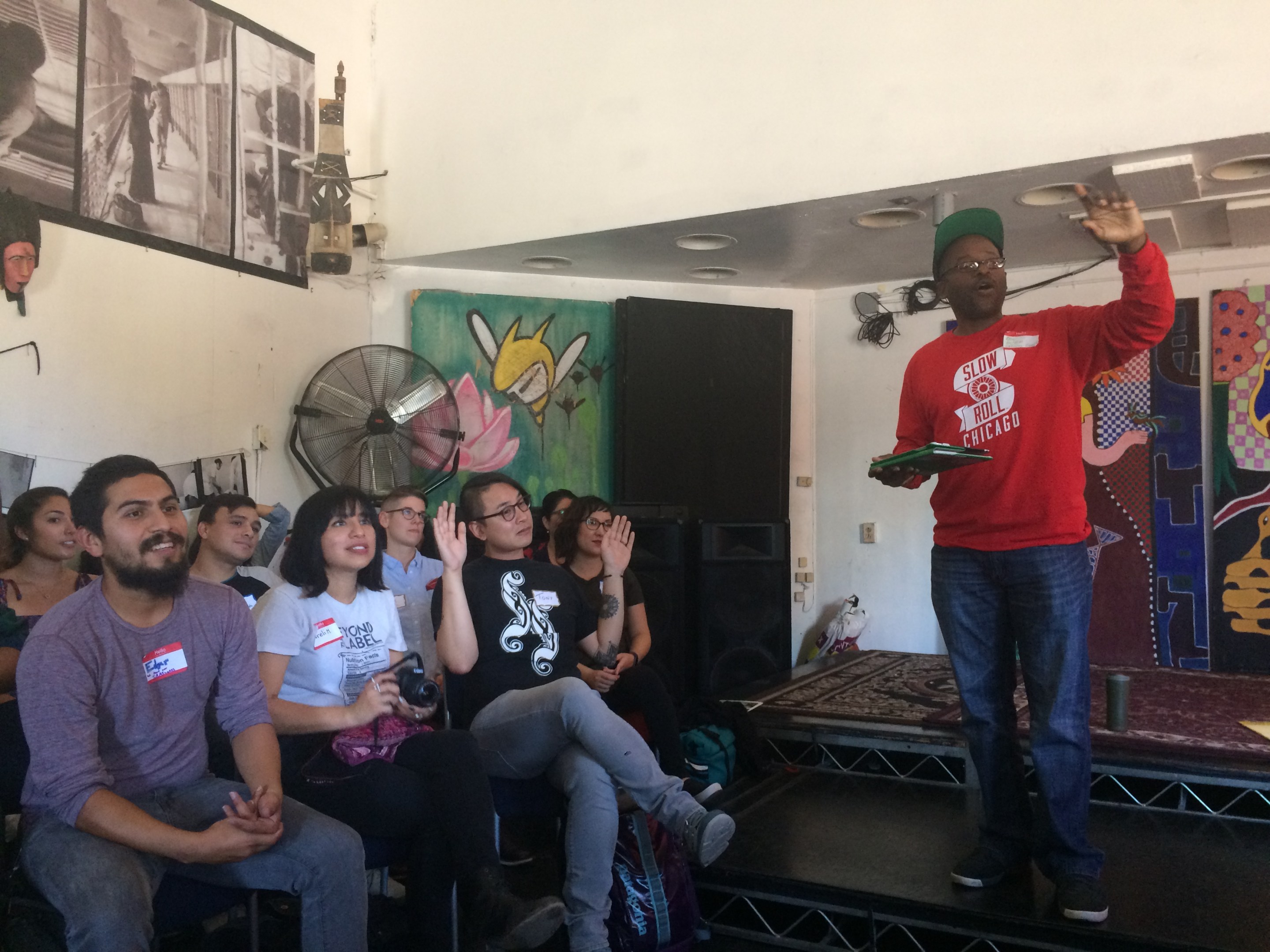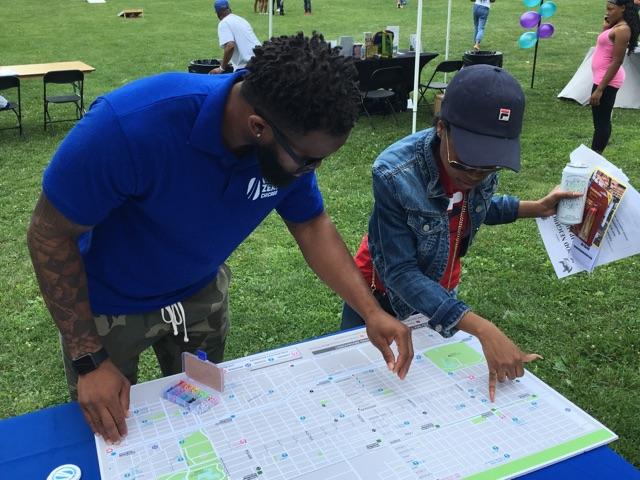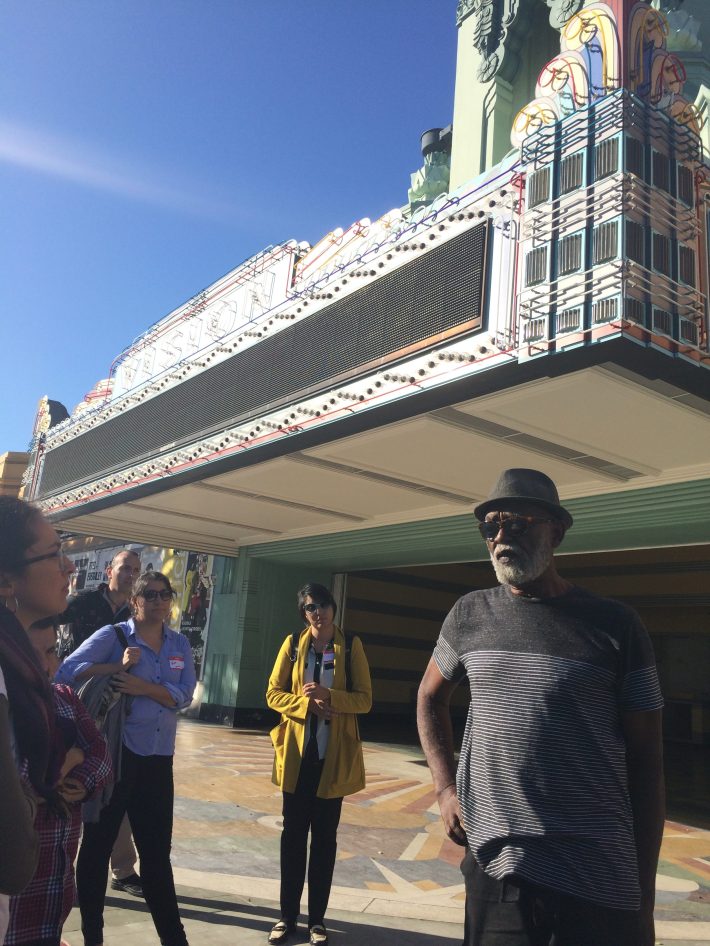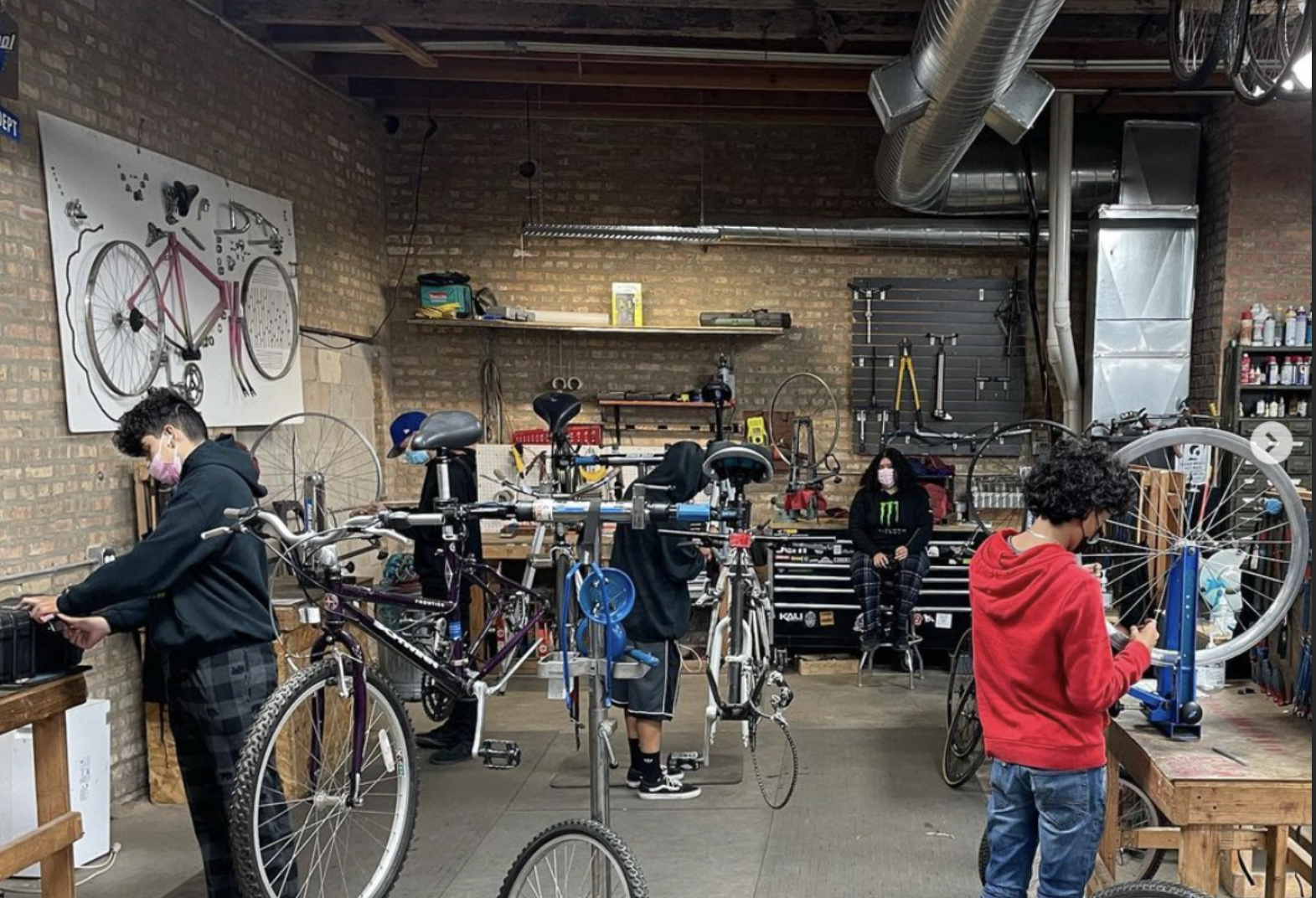Should We Build on, or Burn Down, What Currently Exists?
7:25 PM CST on November 10, 2017

Oboi Reed speaks at The Untokening. Photo: Lynda Lopez
It was fitting that The Untokening mobility justice convening took place last weekend in Leimert Park, a predominately African-American neighborhood in South Los Angeles. While participants grappled with the issue of transportation equity at the event, Leimert Park residents are facing it head-on.
In 2019, the new Metro Crenshaw/LAX light-rail line will open, passing by L.A.'s Leimert Park, Baldwin Hills, Hyde Park, and Inglewood communities. While the new line will help fill a transit gap, there are already concerns about displacement of longtime residents. These concerns are far from unfounded, as highlighted by a new UCLA study. The report found that between 2000 and 2013, neighborhoods near light rail or subway projects were more likely to see an increase in white, college-educated, higher-income households, and greater increases in rents.
Being in Leimert Park that day made these larger questions of mobility justice more tangible. The changes people in Leimert Park are facing reflect the issues communities across the country are experiencing as cities build new transportation infrastructure amidst an affordable housing crisis.
On the afternoon of the event, the group split into workshops, including “Tokenism stories and beyond,” “Storytelling as a tool for resilience,” and “Healing and wellness.” I attended the seminar “Policy/Advocacy/Power led by Oboi Reed, cofounder of Slow Roll Chicago and Equiticity, and Untokening cofounder Naomi Doerner. Part of my motivation for attending was to learn more from Reed, since Slow Roll Chicago stands out as one of the few Chicago organizations working to improve transportation access with a focus on equity, centering people from low-to-moderate-income communities of color on the South and West sides. His saying “We ride bikes to make our neighborhoods better” captures the essence of Slow Roll. (Attorney Brendan Kevenides and his firm FK Law provided funding for Reed and fellow Slow Roll leaders Romina Castillo and Dan Black to attend the event.)
Before jumping into the content, attendees were presented with a question that would frame the entire session, “Are you a burner or a builder?” That is, when you approach social change, do you feel it more helpful to continue building off of what currently exists, or should we just dismantle the whole thing to start anew? We would be challenged to consider the implications of both strategies.
Reed started off with a story that may be familiar to many Chicago folks, which reveals his perspective on whether it’s best to burn or build. He spoke about issues he had with the city of Chicago’s Vision Zero plan to eliminate crash fatalities, which is focusing on LMI Black and Latino neighborhoods with high traffic violence rates.
One major concern Reed had upon reviewing the Vision Zero plan was its inclusion of policing as a crash-reduction strategy. The Chicago Police Department’s issues with civil rights abuses have been widely documented. Even the simple act of bicycling has been criminalized in Chicago’s neighborhoods of color – a recent Chicago Tribune investigation found a huge disparity in the number of tickets for bike infractions written in majority-Black areas compared to majority-white ones. Mobility justice cannot exist when our communities are over-policed.

Reed was particularly concerned that the cost, location, and timing of Active Transportation Alliance’s scheduled Vision Zero Summit, intended to highlight the plan, would exclude residents of this year’s focus communities on the West Side, and he noted that no people of color were scheduled to speak. “I decided I was done playing the inside game,” Reed said. “I wanted to play the outside game to burn it all down.” Reed and Slow Roll Chicago called for the cancellation of the summit, citing lack of the lack of inclusion. Active Trans subsequently announced they would postpone their event.
Doerner expanded on this subject, discussing her experiences working for social justice from the inside through her job at a city agency in Seattle, where housing prices are skyrocketing, accelerating displacement.
I found it compelling to think about social change through the concept of burn or build. How do we decide when to use which strategy? Is there a way to merge both? To give attendees an opportunity to wrestle with these questions further, the facilitators laid out a scenario for us.
You have a community of color where residents currently struggle with terrible transit access. The city already has a plan in place to build a light rail line to serve the area, which would close the existing service gap. But the project could involve the acquisition of homes via eminent domain, and the improved transit access will raise property values, and potentially raise housing costs and cause displacement. Do we as a community choose to burn or build?
Throwing another factor into play, the facilitators asked us to consider whether we wanted to burn from the inside or outside or build from the inside or outside. They gave us free rein to interpret the term and approaches. To burn means to essentially kill the plan, which could be approached from the outside in the form of a community organization protesting it. To build means to support the plan, but work to make it more equitable, which could come from the inside in the form of being part of a government agency drafting the proposal.

This scenario reminded me of the current plans for El Paseo, a four-mile trail on an old railroad right-of-way between Chicago’s Pilsen and Little Village communities, which has already stirred gentrification fears. On one hand, Little Village and Pilsen rank in the lower third of all Chicago community areas in terms of amount of open space acreage per person, according to a Chicago Metropolitan Agency for Planning report.
On the other hand, the recently opened Bloomingdale Trail, also known as The 606, an elevated greenway on Chicago’s Northwest Side, has had a dramatic effect on local on real estate prices. West of Western Avenue along the path, single-family home prices have increased 48.2 percent since construction on the trail began in late 2013, according to a report by the Institute for Housing Studies at DePaul University.
This phenomenon has left lower-income and working-class residents in communities like Pilsen and Little Village wondering whether they can have new neighborhood amenities like El Paseo without rising property values, taxes, and rents pushing them out of the neighborhood. This is why cities cannot move forward with major infrastructure, parks, and development projects without taking proactive steps to mitigate the impact on housing costs. Otherwise residents may feel they have to oppose much-needed transit and green space improvements for their communities because of their realistic fears of being pushed out of their homes.
With these competing interests in mind, I was conflicted about how to approach the hypothetical scenario of a new light rail line in a transit-poor community. My first inclination was to burn, especially because the plan had already been created without city officials first consulting the community. However, as someone who has lived in areas with limited transit, could I really say that we should walk away from this opportunity to improved service We discussed the topic in small groups and subsequently shared our thoughts with the other workshop attendees.
One participant said, “We need to build a coalition and create a plan to build from the outside and inside.” Others were in favor of burning it down. “There will be no city council that is not ours,” one attendee said. “How do we meet our needs with a city council that is not meant for us?” Others responded that some people on the inside share some of the values of those on the outside. How do we work together?
The scenario raised a lot of questions and skepticism, especially regarding the lack of meaningful community engagement in regards to the light rail planning.
“Should we take the crumbs that they’re giving us,” one attendee asked. “We get to pick the colors of the train.”
One attendee was adamant about burning it down, citing the fact that the plan had passed city council. “Once money is allocated, it’s over,” he said. “The money is in the bank, the beast is moving. We gotta roll.”

With the question of the light-rail line on our minds, we all toured Leimert Park with long-time resident Ben Caldwell, an artist and filmmaker. Walking around the neighborhood, African-American culture was reflected in everything we saw and heard. We saw Black-owned shops, Black-owned restaurants, and symbols inspired by the African diaspora. With the upcoming construction of Crenshaw/LAX light rail and a number of Black-owned shops already being notified that their leases won't be renewed as landlords get ready to rehab or sell their properties, what does that mean for the future of the community?
We wrestled with these questions as we went to our closing discussion at the Vision Theatre. To close out the convening, attendees were given a chance to take the mic and address the crowd.
One attendee from the Bay Area expressed the worry of new mobility forms approaching and organizations not being prepared to mitigate impacts. “We can’t just build highways or enact mobility forms without considering people.”
Many of the speakers addressed the question of whether to burn or build.
“I vote to burn it all down," said Reed. "The entire institution needs to be burned down. We need to have a national, consistent definition of equity. People nationally and locally talk about equity in an irresponsible manner.”
As I walked out of the convening that day, many thoughts ran through my head, all of them variations on lighting fires and laying bricks. I thought about my own vision of equity and how I can best continue building what that means. I thought about ways I could pursue that vision in Chicago and the people I could trust to share in it.
I was ready to head back home with my host to let my thoughts marinate after a long day of dialogue when Reed approached me to ask, “Want to grab dinner with the Chicago folks?” Discussing the ideas of the day over a Jamaican meal in Leimert Park was the perfect way to conclude my Untokening experience.
Stay in touch
Sign up for our free newsletter
More from Streetsblog Chicago
It’s electric! New Divvy stations will be able to charge docked e-bikes, scooters when they’re connected to the power grid
The new stations are supposed to be easier to use and more environmentally friendly than old-school stations.
Today’s Headlines for Tuesday, April 23
Communities United: Reports of Bikes N’ Roses’ death have been greatly exaggerated
According to the nonprofit shop's parent organization, BNR has paused its retail component, but is still doing after-school programming and looking for new staff.



